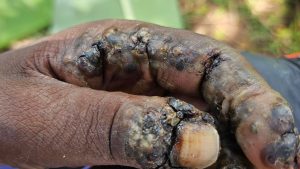

In large geographic
swaths on our planet, people are prey to the pestilence of Tungasiasis. This disease is caused
by the fleas known as Tunga Penetrans (aka jiggers, chigoe or sand fly), that burrow into
human flesh, lay eggs and then the larvae live on the blood of the host. Exposed skin on the bare
feet of people are the most vulnerable areas on the body, but infections are seen elsewhere such
as the hands knees and ankles. Prolonged infection results in gangrene and death. People who
lack basic protections such as footwear or flip flops, present easy targets for burrowing fleas.
Jiggers impact marginalized communities of low socio-economic status—mostly those who live
on less than $1 a day, in rural locales, with no access to medical care. Jigger infestations occur in
poor populations and can be as high as 60% with older adults, the disabled, and children 5-14
years being the most impacted. Tungiasis is often associated with social stigmatization.
The affliction is found primarily in sub-Saharan Africa (SSA). The jiggers have migrated there
from Central and South America.1 Despite the known epidemic of jiggers,
they are a largely unexplored affliction and very little governmental and
private sector partnerships exist to provide relief. Most of the treatment is
given free by non-profit groups. Removing jiggers outside medical facilities
is a primitive process—using small scalpels, and without pain medication.

This document relates to the UN SDG #1: Poverty, and SDG #3 Health and Well-Being. This commentary focuses
on tungiasis in Sub-Saharan Africa, but it is present in the Caribbean, Central and South America, and India, but
not in Europe or North America.




